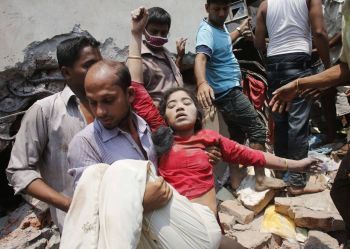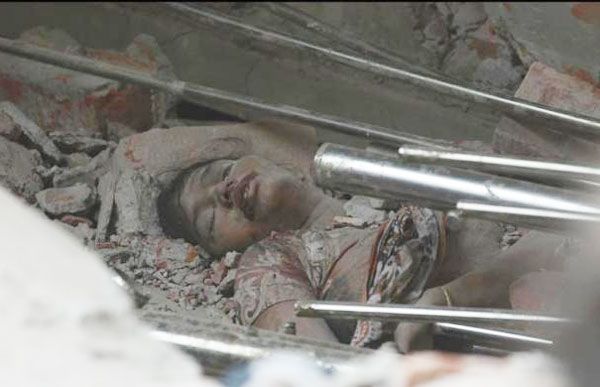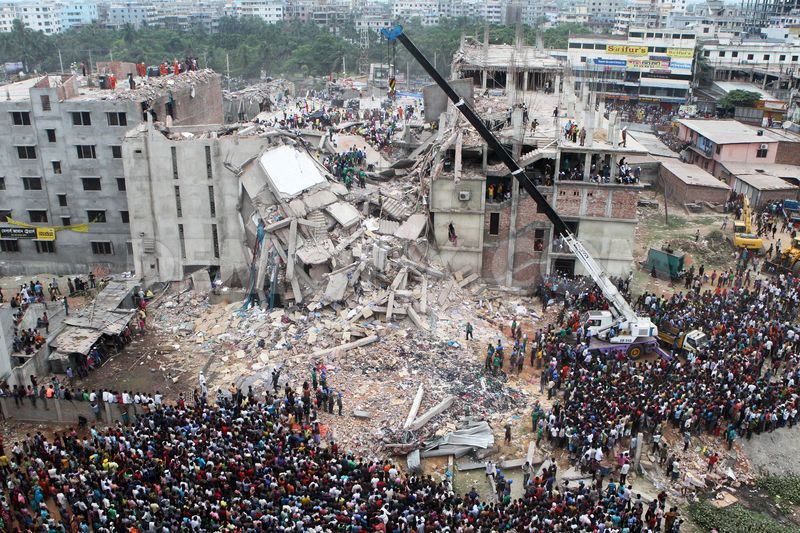
Publisher:
Bonnie King
CONTACT:
Newsroom@Salem-news.com
Advertising:
Adsales@Salem-news.com

~Truth~
~Justice~
~Peace~
TJP
May-10-2013 12:54

 TweetFollow @OregonNews
TweetFollow @OregonNews
Reason and Responsibility: the Rana Plaza Collapse
William Gomes Salem-News.comThe Rana Plaza tragedy was an outcome of a corrupt system that is rotten to the core. Who should - and can - be held accountable?
 Courtesy: enca.com |
(YORK, UK) - The deadly collapse of a building in Bangladesh late last month made news around the world and brought the country back into the western media spotlight. On 24 April Rana Plaza, a eight-story building housing several garment factories, situated in Savar, 24 kilometers outside Dhaka, was reduced to rubble leading, so far, to the death of over 800 workers.
 Rana Plaza - courtesy: demotix.com |
The 3.6 million strong communities of men and women working in the garment industry have enabled Bangladesh’s position as the world's second-largest apparel exporter. In the absence of basic workplace health and safety standards, these workers have become the victims of systematic human rights violations, suffering while others get rich to make fashionable clothes for faceless consumers. The very market that created the masterminds who are root and reason for this injustice remain untouched, while people continue to argue over responsibility for the deaths of these workers. Whether it’s the garments owners, government, buyers, retailers or consumers in the West, no one wants to take responsibility, instead pointing the finger at others.
From crack to collapse
According to media reports workers at Rana Plaza saw the cracks in the huge structure the day before the collapse but the authorities did not take any precautionary steps. The building owner Sohel Rana allegedly told media on the same day that the cracks were “nothing serious” and on 24th April, the day of the deadly incident, workers were forced to work and threatened with a month’s salary cut if they did not comply. All this in the country with the world’s lowest minimum wage. Rana has been described as “the most hated Bangladesh”, but an important detail has been missed in much of the reporting: Rana is not the owner of the garment factories nor did he decide whether the garment factories would remain open or not. Rana has been an easy scapegoat, as the building is named after him, but what about the systemic failings behind the front man?
Industrial police had asked the garment factory owners at Rana Plaza to keep the factories closed and only continue further operations after consulting with expert structural engineers. The question that remains unaddressed is: why did the factory owners and Rana work from the same playbook, and ignore this crucial advice?
The politics-business nexus
The politics-business nexus has long been the subject of public debate and discussion in Bangladesh. CNN’s Christiane Amanpour has noted that many politicians of the two major political parties—the ruling Awami League (AL) and the Bangladesh National Party (BNP)—have garment businesses. But another example is the case of the Bangladesh Garment Manufacturers and Exporters Association (BGMEA), an organisation that has been referred to frequently in international media as keeping a tally of the numbers dead in the Savar tragedy, and one that has demanded punishment for those responsible for it. It is not without irony that their stylish high-rise headquarters in the Bangladeshi capital were illegally built, according to the verdict of the country’s Supreme Court, which ordered the government to demolish the building within 90 days.
 |
The Bangladesh Prime Minister, Sheikh Hasina, has callously dismissed the tragedy in Savar by stating on CNN that “accidents happen,” much to the shock of her interviewer. In fact, Hasina’s Home Minister, Muhiuddin Khan Alamgir, in an interview with BBC Bangla, claimed, without a shred of evidence, that opposition party supporters may have shaken the building after the cracks appeared, which may have lead to the deadly collapse. Additionally, Finance Minister Abul Maal Abdul Muhith remarked, after the death toll had surpassed 530, that the disaster wasn’t “really serious.” These comments exemplify well the kleptocracy behind Bangladesh’s democratic façade.
Not only did Prime Minister Sheikh Hasina publicly deny the owner of Rana Plaza’s affiliation with her political party, the Member of Parliament representing Savar, Murad Jang, publicly denied that Rana was ever associated with party politics. Shortly thereafter, Rana’s affiliation with Murad and his political activities as a member of the ruling party were exposed in the media.
Illegal building extensions
Emdadul Islam, chief engineer of the state-run Capital Development Authority, told media that the owner of the building had not received the proper building consent, obtaining a permit for only a five-story building from the local municipality. The building was, however, illegally extended by a further three stories to a total of eight—an act ignored by the authorities due to Rana’s political connections.
 |
Following the collapse, garment workers took to the streets in protest and demanded the arrest of Rana and the factory owners. In response to the agitation Prime Minister Sheikh Hasina ordered police to arrest Rana and the owners of the garment factories that were operating in the building. On 28th April Rana was arrested while he was trying to flee to India by road and brought back to Dhaka.
The Rana Plaza tragedy was an outcome of a corrupt system that is rotten to the core. The building was built without observing proper building codes and laws, and using poor materials—something that should have been monitored from the beginning by concerned authorities of the Bangladesh government, whose negligence is particularly culpable in this instance. Unfortunately, in Bangladesh, any kind of permission for high-rise buildings can be obtained through bribes, and the building can be built without procuring suitable building materials.
Sohel Rana, the owner of Rana Plaza and a Senior Joint Convenor of Awami League’s youth front Jubo League in the Savar municipality unit, constructed Rana Plaza in 2007. He did so by taking permission from the Savar Mayor, an Awami League member, who, in fact, had no authority to issue this permit. This is all beyond the point, however, and the fundamental question remains: what were the government authorities doing for so long if the building was constructed without proper permission years ago?
Who is responsible for the Rana Plaza tragedy?
In recent years the rapid expansion of the ready-made garments industry in Bangladesh has resulted in an increased demand for high-rise buildings. Many ordinary buildings have been converted into factories and sometimes the owners of buildings add extra floors without proper permission, as was the case in Rana Plaza. In this particular case various government authorities have notably failed to inspect and monitor the illegal establishment of Rana Plaza. Even after the cracks on the building were broadcast in local media, the government failed to act in a way that could have saved the lives of hundreds of extremely impoverished workers. In addition to the role played by Western companies that profit from Bangladesh’s cheap labor, Western media would do well to focus on and expose Bangladeshi political corruption to a global audience.
The systemic failure of government protection of human rights and lack of respect towards workers’ right allows incident like Rana Plaza to continue to happen. Beyond the famously low wages, unsafe working conditions and restrictions and repression of labour unions plague the industry. The state has a duty to protect its citizen against human rights abuses by third parties, including business enterprises, through regulation, policymaking, investigation and enforcement. But policymakers are also part of this profit-making business and are strong protectors of corruption mechanisms. Today, there's nothing but false promises and dirty politics from all parties. When the state itself protects the oppressors and limits access to judicial, administrative, or legislative protection and corporate responsibility, prevention of any infringement of rights remains a dream for many of the victims of serious and systemic human rights violations.
The Rana Plaza disaster is now making history as among the worst industrial accidents in Bangladesh, with a rising death toll and scores more critically injured. The accident follows a fire at the Tazreen Fashion factory and Smart Fabrics on the outskirts of Dhaka on 24 November 2012, leaving at least 117 dead and at least 200 injured. It was the deadliest factory fire in the nation's history; but the scale of the tragedy has now been surpassed by the Rana Plaza incident.
Now is the time to start wide ranging protests in the UK and other parts of the western world, to make the local people aware of the deadly work environment and the deaths of these poor workers by the profit-hungry business people who control the clothing industry.
Special thanks to OpenDemocracy.net
 |
Donate to Support William's Human Rights Stories; donate through PayPal
Donate to: williamgomes.org@gmail.com

Salem-News.com Human Rights Ambassador William Nicholas Gomes is a Bangladeshi journalist, human rights activist and author was born on 25 December, 1985 in Dhaka. As an investigative journalist he wrote widely for leading European and Asian media outlets.
He is also active in advocating for free and independent media and journalists’ rights, and is part of the free media movement, Global Independent Media Center – an activist media network for the creation of radical, accurate, and passionate telling of the truth. He worked for Italian news agency Asianews.it from year 2009 to 2011, on that time he was accredited as a free lance journalist by the press information department of Bangladesh. During this time he has reported a notable numbers of reports for the news agency which were translated into Chinese and Italian and quoted by notable number of new outlets all over the world.He, ideologically, identifies himself deeply attached with anarchism. His political views are often characterized as “leftist” or “left-wing,” and he has described himself as an individualist anarchist.
 |
 |
Articles for May 9, 2013 | Articles for May 10, 2013 | Articles for May 11, 2013

Salem-News.com:



Terms of Service | Privacy Policy
All comments and messages are approved by people and self promotional links or unacceptable comments are denied.
[Return to Top]
©2025 Salem-News.com. All opinions expressed in this article are those of the author and do not necessarily reflect those of Salem-News.com.